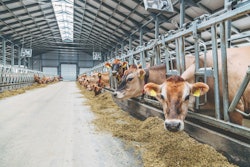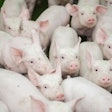
Unlike current human-nutrition trends, essential fatty acids are still regarded with traditional aplomb among many pig nutritionists, but times are changing.
Fatty acids are the component blocks that bind to glycerol to form fats (solid) and oils (liquids), or as they are called in chemistry, triacylglyceride esters.
There are many different fatty acids and their different combinations with glycerol gives us the plethora of high-energy fats and oils we use in pig feeds. Lipids or ether extracts are two other all-inclusive terms used to describe fats and oils, and although neither precise nor accurate, they are good enough for feed manufacturing purposes.
Commercial situation today
In typical pig nutrition terms, fats and oils are considered very much the same as they contribute more or less the same amount of energy – their primary reason for inclusion in most feeds.
Any inherent variability due to composition is significantly much smaller than the extensive variability observed under commercial conditions in terms of factual product quality. For all pig diets, adding 0.5% oil/fat is considered the minimum to enhance die lubrication for pelleting and/or prevent excessive feed dustiness in meal feed.
If dietary energy enhancement is the required outcome, then adding up to 6% of any good quality fat/oil is the norm, as most feed manufacturing and handling machinery cannot easily cope with more than that, with some notable exceptions.
It is only in the first couple of piglet diets where we distinguish between different sources of fats and oils, but this has to do more with digestibility/palatability issues rather than any more sophisticated role.
Metabolism and essential fatty acids
Traditional nutrition books consider three fatty acids as essential, but this requires today some further clarification.
First, there is linoleic acid that is absolutely essential, in that the organism cannot create it and, as such, pigs must receive it from feeds. Luckily, common feedstuffs contain plenty of this fatty acid, which belongs to the omega-6 group.
The second essential fatty acid is arachidonic, also a member of the omega-6 family, but modern research has demonstrated the organism may be able to synthesize it if supplied with enough linoleic acid. This finding is as recent as 2011, and thus it is still under investigation, especially because we do not know how much linoleic acid is enough to cover arachidonic acid requirements; not that we have ever established a requirement for the latter.
The third and last essential fatty acid is linolenic acid that belongs to the omega-3 group and it is used to synthesize other omega-3 fatty acids. Again, the essentiality of this fatty acid is considered debatable and actual requirements are unknown.
Of course, all fatty acids can be “burned” down to provide energy, but some are converted into other useful compounds, such as components of cell walls, hormones and that of the immune system.
The list of their uses is vast, but under commercial conditions, growing pigs usually grow significantly less, whereas breeding animals fail to reproduce efficiently, and all suffer from issues such as scaly skin, hair loss, internal organ failure, hormonal imbalances, impaired immunity, and many other miserable conditions.
Thus, fatty acids are more than a dense form of energy. The fact that the organism can convert almost all of them, and there are many, shows how important they are to leave them to chance encounter in natural feeds.
Modern human nutrition lessons
Human nutrition scientists have given plenty of thought on the bioactive properties of essential fatty acids; pig nutritionists, not so much. Perhaps, this is because requirements for any and all of the above essential, semi-essential, or conditionally essential fatty acids are non-existent.
Most authorities believe a diet with 0.1% linoleic acid is good enough, but this research is based on data from 1985. Today, nutritionists realize this might not be enough, especially for breeding animals.
In human nutrition, we have come to appreciate that the ratio between omega-6 and omega-3 fatty acids may be as important as the individual fatty acid concentration. This is because omega-6 fatty acids, branching out from arachidonic acid, are responsible for pro-inflammatory component synthesis. This is useful under certain circumstances, such as an acute disease challenge or during intensive muscle growth (but how much is uncertain), and a detriment under others.
The opposite is true for omega-3 fatty acids, as these are responsible for anti-inflammatory component synthesis. Again, this can be useful, for example, if the diet contains innate inflammatory components (such as in some legume-based diets), but counterproductive if inflammation is a required normal response and it is inhibited.
As it happens today, the ratio of dietary omega-6 to omega-3 fatty acids favors omega-6 as the latter are found in greater amounts in the common dietary ingredients for humans and pigs. In modern nutrition cycles, a shift toward more omega-3 is believed to be the healthy way to go.
Feed sources of essential fatty acids
Although we have no clear (or even unclear) indication regarding actual requirements even under non-challenging conditions, we still want to ensure pigs consume enough fatty acids to cover their bioactive roles. As mentioned already, the requirement for linoleic acid is considered as easily covered by most common feedstuffs such as corn and soybean meal, whereas vegetable oils and animal fats contain also more than enough of this fatty acid.
Nevertheless, as we depart from common feedstuffs, we need to ensure that at least 0.1% linoleic is present in the final feed, and perhaps more for certain animals.
Arachidonic acid is a bit more difficult to encounter, and it might be true it becomes semi-essential only if the previous fatty acid is close to its minimum 0.1% concentration. Arachidonic acid abounds in animal-derived ingredients, and the trend toward banning or removing such ingredients from a diet of an omnivorous animal such as the pig may be the reason why we need to pay more attention to this fatty acid.
Humans who eschew animal-derived food pay more attention to their arachidonic fatty acid intake, by consuming nuts, algae, and other foods not easily found in animal nutrition.
Finally, omega-3 fatty acids and, of course, the most important, conditionally essential linolenic acid, abound in fish-derived components, especially from fatty-fish species. Lamentably in pig nutrition, fish meal has become a luxury, when it used to be an almost indispensable ingredient.
Luckily, a good source of omega-3 fatty acids is a land-based protein source in the name of linseed (flaxseed), whereas more modern thinking is looking at (ancient) algae as the next breakthrough in omega-3 nutrition for all animals.
Currently, animal products such as eggs enriched with omega-3 fatty acids through the use of linseed oil are considered very trendy among health-conscious consumers. Again, there is uncertainty which and how many of each of the many omega-3 fatty acids should be consumed under each challenging condition, but nevertheless, given the present situation, the recommendation for humans is certainly for rather more.
The same can be said for pigs, but here there is a greater degree of uncertainty – and perhaps opportunity or potential for loss – all of which can be addressed by more research and, of course, end-user education.
Final recommendations
For now, I would keep the 0.1% linoleic recommendation as the minimum dietary specification for all pig feeds, and I would increase it up to 0.75% for breeding animals.
It would be interesting to monitor arachidonic acid if non-traditional ingredients are used and/if linoleic acid concentration drops considerably. I would not advocate the involuntary conversion of pigs into vegans, especially if animal-derived ingredients can be used safely.
Finally, I want to encourage all of us to continue monitoring research on omega-3 fatty acids in pigs, as not all groups of omega-3 fatty acids are the same, and currently we do not know which one is best suited for each required purpose.
For more practical purposes, I would try to bring back some fish meal, or the equivalent group and amount of omega-3 fatty acids found in fish oil, trying to replicate the presence of fish meal oil. Here, my focus would be diets with inflammatory potential and animals under chronic disease pressure at the subclinical level.
















